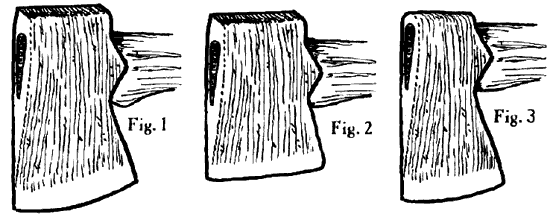John White, 1stMaryland Regiment
HISTORY:
In 18th century British North America, axes were in common use throughout the area settled by Europeans. Early axes were brought from the mother country and subsequent production tended at first to follow familiar patterns. Each region tended to cling to established patterns. Indeed, late 19th century American ax manufacturers had to offer dozens of varying patterns in order to satisfy regional tastes. Today few patterns survive in production, mainly due to the decline of logging by manual methods.
The one pattern still made in this country which would be most easily recognizable to an 18th century axman is the so-called Jersey pattern (figure 1). This unique American pattern (often called a Yankee ax in Europe) was fully developed by the mid 18th century. Earlier versions of this ax, developed from so called trade axes, had a much longer bit and no poll (figure 3). Later developments often had a very short bit, looking very squarish compared to today’s pattern (figure 2). For illustrations of many correct 18th century ax styles, I recommend reading the “Collector’s Illustrated Encyclopedia of the American Revolution”. Please see the bibliography at the end of this article for more information.
HANDLE STYLES:
As to handle styles, almost all evidence indicates that the preference was for straight handles, probably because they were rather easy to fashion by hand from a piece of straight grained wood. Sometime a knob at the end helped keep the handle from slipping from one’s grasp. The currently common curved handle with the “deer’s foot” knob apparently gained popularity after the availability of machine carved handles about 1850. When examining old hand made handles, one is surprised by how much slimmer they were than modern handles. The best modern handles are made from hickory, but they are made heavier to minimize breakage, as mass production doesn’t allow selecting exact wood grain patterns to match the particular style of handle being made.
HANDLE REPLACEMENT:
First drill out the old handle remains. Often the replacement handle will have to be shaved or filed with a wood rasp to make it fit through the eye which is tapered from both top and bottom to the smallest dimension about in the center. Don’t make it too loose or you will never get a solid fit. The replacement handle can be driven in without fear of breaking if you hold the ax head in the air (with inserted handle) toward the ground and hit the handle end smartly until it is firmly seated. The physics involved is, since the handle has less mass than the head, it accelerates faster, thus moving more quickly than the head. The handle should normally protrude a little above the top of the ax. If more than a quarter inch, cut if off. Then drive in the wood wedge (a spot of glue will help insure it won’t loosen). Although we don’t think the added steel wedge was used in the 18th century, it further protects against loosening. If necessary, cut the handle more or less flush with the ax top for a finished look.
HANDLE FINISH:
If the handle has a glossy modern finish, you may want to remove it for more authenticity. Old timers often would use broken glass as an efficient (and cheap) method of scraping wood. However, most of us would not want the hazard of using this approach. We have found that the back edge of an old hacksaw blade works great. And when it gets dull, it can be re-sharpened many times. To make it easy to work with, cut an appropriate length of old hose (see figure 4) and slide in the blade and use it like a draw knife. Finishing with sandpaper is not usually necessary. We recommend yearly treatment of the handle with a one third mixture of turpentine or mineral spirits to two thirds boiled linseed oil. Let dry thoroughly. Dispose of oily rags safely, as raw linseed oil has been known to cause spontaneous combustion if stored improperly.
SHARPENING:
The bit should be kept sharp by grinding with a wetted slow speed stone or by using a file. A cutting edge of about 30 degrees is recommended for normal cutting use. Start with a coarse file and finish with a fine one, if available. You can purchase specially made files for such purposes which are coarse on one side and fine on the other. Since files are much easier on the hands if they have handles, correct period handles can be made from wood, horn, antler, corn cobs or other items limited only by your imagination.
USAGE:
Several books in the bibliography (see asterisks) have lengthy instructions on proper ax use. We do, however, want to stress the fact that ax polls were designed to give good balance to the ax, not as a striking tool. The eye is normally not thick enough to withstand heavy battering. We have seen many axes seriously deformed, or broken because they were used as a sledge hammer. If you must hammer, use a mallet or a maul. An ax properly used and maintained can last several lifetimes.
BIBLIOGRAPHY
- AMERICAN AXES Henry J. Kauffman, The Stephen Greene Press, Brattleboro VT 1972.
- A MUSEUM OF EARLY AMERICAN TOOLS Eric Sloane, Wilfred Funk Inc., 1964.
- DICTIONARY OF TOOLS used in the woodworking and allied trades, c. 1700-1970 R.A. Salaman, Charles Scribner’s Sons, NY 1974.
- ANCIENT CARPENTERS TOOLS Henry Mercer, Bucks County Historical Society, Doylestown PA. 1929 (Reprint 1962).
- THE AXE BOOK Granfors Bruks AB. Sweden. Available from: Granfors Bruks Inc. PO Box 818. Summerville SC 29483
- HEATING YOUR HOME WITH WOOD Neil Soderstrom, Harper & Row NY 1978.
- SWORDS AND BLADES OF THE AMERICAN REVOLUTION George C. Neumann, Scurlock Publishing Co. Texarkana TX 1991.
- COLLECTORS ILLUSTRATED ENCYCLOPEDIA OF THE AMERICAN REVOLUTION George Neumann & Frank Kravic, Scurlock Publishing Co., Texarkana TX 1975.

